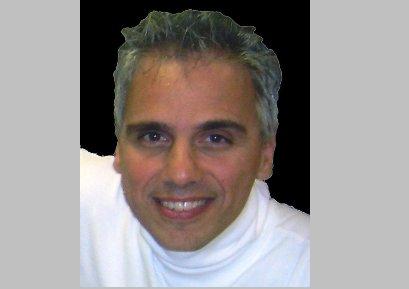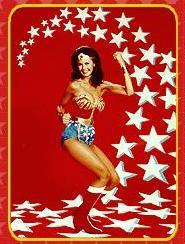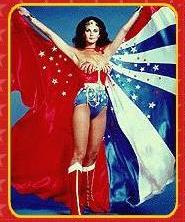Herbie J's Retrospective on the original "Wonder Woman" series (featuring exclusive commentary from Lynda Carter) - Herbie J Pilato

This commentary was originally posted inStarlog Magazinein 1999.
Years ago, Lynda Carter & Lyle Waggoner found adventures in Wonder Woman.
What's the best way to describe Lynda carter's interpretation of the comic book/TV heroine Wonder Woman? Simply, wonderful.
From 1975 (in ABC's World War II setting) to 1979 (the CBS contemporary version), the statuesque actress portrayed the super heroine with humor, grace and style, entertaining viewers of all ages. Carter's Wonder Woman endures today as a pop icon through reruns on the Sci-Fi Channel and elsewhere.
Many fans were drawn to the program because Carter -a former Miss World USA- was (and remains) stunning, dressed in her patriotic one-piece. But others tuned in simply because Carter made Diana Prince human and approachable. "That's exactly what I tried to do." she says. "Wonder Woman possessed super powers, but her special abilities did not solely define who she was. With Wonder Woman, people had a chance to see something that they hadn't seen before on TV -a physically able, emotionally and psychologically stable, independent woman with a fantasy element."
AMAZON ADVENTURES
In March 1974, ABC aired the first Wonder Woman pilot, written by John D.F. Black and directed by
By late 1975, Carter had replaced Crosby as The New, Original Wonder Woman in a second, successful version, along with Lyle Waggoner as the new Trevor. In this incarnation, set during World War II, U.S. Army pilot Trevor was shot down by Germans in a remote section of the Atlantic, crash-landing on Paradise Island, an uncharted isle inhabited by agile, nubile and immortal Amazons, Princess Diana nursed Trevor back to health, fell in love with him and returned to America with him (after erasing his memory of Paradise Island with a drug). Before long, as Wonder Woman, she was facing Nazi spies out to steal an advanced bomb prototype.
In 1977, The New, Original Wonder Woman left ABC for CBS and became a weekly series entitled The New Adventures of Wonder Woman. Its third pilot, written by Stephen Kandel and directed by Alan Crosland, took place 32 years after WWII, with the immortal Princess Diana having long since returned to Paradise Island. She again discovers a downed U.S. aircraft on the island, this time carrying government agents. One passenger, to Diana's amazement, appears to be a youthful Trevor, The agent is, in fact, the original Trevor's load ringer of a son (also played by Waggoner), who works for the Inter-Agency Defense Command (IADC). Diana resurrects her Wonder Woman persona and teams with Trevor Jr. to combat evil, assisted by IRA (a.k.a. Internal Retrieval Associative), a talking computer who knows her true identity.
Though producers Wilfred Baumes, Charles B. FitzSimons and Mark Rogers worked on the various shows, it was executive producer Douglas S. Cramer, a one-time Paramount Pictures Television producer responsible in part for such hits as Love, American Style, Mannix and Room 222, who initially retooled Wonder Woman to match Moulton's classic image.
According to Cramer, the key to Wonder Woman's success was four-fold, starting with the Ugly-Duckling-into-a-Swan transformation. "There really was the sense that this plain, ordinary woman Diana Prince could turn into someone special like Wonder Woman. This aspect, which gave hope to many who were without hope, was really at the heart of the show's appeal."
Next, there was the non-lethal content. "Virtually no one was ever really killed on the show," Cramer says. "People would get tossed and even shot at, but no one would ever die. They would always bounce right back."
Another component was the mythical Wonder-Land aspect. "Wonder Woman's heritage, her coming from another place [Paradise Island] was equal to the Superman mythical, extraterrestrial origins. That concept has always appealed to people."
Finally, and most importantly, there was the Women's Liberation element. "We have to remember that the series appeared just as women in our country were really beginning to voice their emancipation. In many ways, Wonder Woman was a sign of the times."
CO-STAR CAMP
But sultry super-suffragettes do not a series make. Enter Waggoner, the handsome romantic-
"Lyle was always so chipper on the set," says Carter. "I think because his business got off to a good start." Waggoner, while filming Wonder Woman, began Star Waggons Inc.-a manufacturer and supplier of studio location trailers that's still the top choice of Hollywood production companies. "He was also just a really content and happy guy. All that joy and excitement bubbled over into his performance."
"He was ideal," notes Cramer. "With his good looks, leading-man ability, years of experience and comic polish from the Burnett show, there was no one better to fit the role.
"In fact," Cramer adds, "all those cast around Lynda were essentially comedic actors. We had Richard Eastham [as General Blankenship] and Beatrice Colen [Corporal Etta Candy], and they were each tremendous at playing camp, and adept at comedy."
Despite the Ross connection, Waggoner had to audition. "And I almost didn't get it," he laughs." I knew it was a cartoon, and that it was a put-on, but you had to play it with a straight face. You had to say sill lines seriously and hopefully make the viewer at home smile."
Waggoner's tongue-in.-cheek performance fit perfectly the "war-corn" premise of the 1940s Wonder Woman, and he was "quite fond" of those early shows. But the second season saw the war's end, which did not please Waggoner. "They should have kept it the way it was," he says. "The entire laugh at-yourself view of the show was gone when we moved into the 1970s. There were not many shows at the time that took jibes at themselves like we did. It was unique, and I was sorry to see all that altered."
One alteration Waggoner couldn't get used to was the change in the Prince disguise. Gone was the uniform that Yeoman Prince had worn during WWII, along with her military cap and hair tightly done up in a bun. After a few episodes in the present, Diana Prince now looked more glamorous, sporting only glasses as a ruse, and soon she was not wearing even those; her raven tresses were likewise only swept back in a pony tail.
"I always felt silly playing Steve in those moments," Waggoner admits. "To look straight at Diana and not be able to say that I recognized Wonder Woman, now that took a bit of acting. I just think the show would have stayed on a lot longer if they had left her fighting Nazis. It was so much more fun."
HEROIC AUDITIONS
Carter entered the hero biz through Alan Shane, head of casting for Warner Bros. Shane introduced Carter to Cramer, who was responsible ford her getting the part. "She was so far ahead of any other actress up for the role," insists Cramer.
Unfortunately, ABC didn't agree, preferring someone with more experience. "There were those at ABC," Cramer notes, "who felt that Lynda could not have carried a show of her own, because she had not previously appeared in a series. But the minute she stepped into that wild costume, I knew-and we all knew-that we had found our Wonder Woman."
That included co-star Waggoner, who had screen-tested with all the actresses auditioning for the amazing Amazon. "Lynda, in my opinion, looked the part. And I don't know how much weight that carried, but that was my suggestion."
Cramer however, was easily Carter's staunchest supporter. He even refused, at once point, to produce the series if it didn't feature her. "Unless I get to cast thin girl," he restates. "you can forget it. She is Wonder Woman. She resembles her exactly, she can pull off and there's just no point in doing it without her."
Ironically, Carter had tested for -and of course didn't get-the first Wonder Woman pilot. "I didn't even get a callback for that one," she says. But eight or nine months later, when Cramer set out to revamp the concept, Carter's phone rang, and an interview for the second pilot was scheduled.
"I walked in," Carter recalls of the conference, "expecting, of course, that anyone who was anyone in television would be there. And they were, the whole gang: Farrah Fawcett, Jaclyn Smith, Kate Jackson, Suzanne Somers, Lindsay Wagner, Cheryl Ladd. We all went to the same auditions, at the time. None of us had done that much, just a couple of commercials and small parts on various shows. Kate was really the only one with any extensive experience [i.e., The Rookies]. The interesting thing is that we didn't have to do a cold reading, which I've never been too fond of anyway. I never won a role from doing one. I'm terrible at them. I freeze up."
It didn't matter. Cramer had warmed up to an early screen test of Carter's, and told her it was unnecessary for her to audition. "So, I just went home," the actress says, "very keyed up and excited. Here I was, this brand new actor, just starting out and studying, without anything but a couple of bit roles to my name, and Doug was ready to cast me in the lead. He really went to bat for me, and I was thrilled."
As was ABC when the second Wonder Woman pilot became a hit. Periodic one-hour specials followed, broadcast by the network to fill in for its other super heroine, The Bionic Woman (temporarily off the air while Wagner recuperated from an auto accident).
ABC passed on the show after two years. "They believed the WWII storylines were too limiting," Carter says, "with the only major villains being the Nazis. They thought if we took it into the 1970s, there would be more to explore, from a creative standpoint."
Jerry Lieder, then-president of Warner Bros. Television, went to CBS with the notion of shifting the series ahead in time. CBS bought the idea hook, line and magic lasso. "It was a fresh approach," admits Cramer, who was initially afraid of the change, "which CBS thought would reach a wider audience. Because, at the time, the other superhero shows, like The Incredible Hulk [also on CBS] and The Six Million Dollar Man [ABC], seemed more real in comparison, if you can imagine anyone saying such things about SF-adventure shows."
Cramer believed it was the campy WWII version that first appealed to viewers, and told Lieder that "there was no way to play it straight in a contemporary setting, and that it must be produced with its tongue firmly implanted in its cheek. Those first [WWII] episodes are the ones people still talk about and remember the most."
After talks between Lieder and Cramer, the idea was sold to CBS. The network executive in charge of series production at the time was programming whiz Brandon Tartikoff, who, Cramer notes, "also understood exactly what the concept of Wonder Woman was supposed to be.
"Many people involved with the show," adds Cramer, "were just really grown-up children. We had writers like Bruce Shelby and David Ketchum [who penned dozens of Love, American Styles for Cramer at Paramount]. They had never done one-hour drama shows before, and they needed the story and dramatic beats worked out for them. But they brought the humor to Wonder Woman that 1 thought it required."
Also aboard from Love, American Style was Stuart Margolin (Angel from The Rockford Files) who directed several Wonder Woman's. Other behind-the-camera talent included directors Seymour (Bewitched) Robbie, Alexander Singer, Michael Caffey, Jack Arnold, John Newland, Gordon Hessler and the late Herb Wallerstein.
"Herbie was always a frustrated director," Cramer states, "so we let him direct Wonder Woman, mostly because his particular sense of the world was right for the show. He had the passion that we all shared. We were all very clear on the show's vision, and respected that vision. We were all very particular on what Wonder Woman and Steve would or would not do. There were often long, detailed discussions about [whether] she, under one circumstance with one particular villain, would or would not use, for example, her magic lasso.
"The one thing that we didn't do, that I always wanted to do," says Cramer, "is run with more regular heavies, as on Batman. But everyone was really afraid of doing that"
CINEMATIC WONDERS
Today, with countless old TV shows reincarnated as movies, can a theatrical version of Wonder Woman be far away?
"It has been in development at Warner Bros. for four or five years," says Cramer. "I tried to sell it myself on a number of occasions, but I kept on getting turned down, because I'm not known in the feature film world. Now, however, Jon Peters is developing one" with director Ivan (Ghostbusters) Reitman. At one point, Lois & Clark's Debra Joy Levine was developing a Wonder Woman 'TV project.
If he could be part of a Wonder Woman revival, who would Cramer cast in the lead? "I would definitely go with an unknown," he replies. "It would be a huge mistake to go with someone like a Jennifer Aniston, God help us, or a Cameron Diaz. The strategy must be like it was when we did the series with Lynda, who was an unknown, or like when they remade Superman."
So would Carter slip back into those Wonder Woman togs for a feature film version? "You never know how things will turn or what's around the corner," says Carter, who lives in Washington D.C. with her husband, lawyer Robert Allman, and their two children, James and Jessica. "Wonder Woman has always had a life of her own, for whatever reason. Why it reached into the hearts of so many people may never be fully explained."
Carter still gets lots of fan mail, including "a wonderful letter" from a woman who, in a college thesis, named Wonder Woman as the inspiration for her career. "She came from an underprivileged background," Carter explains, "and she went out and attained what she wanted in life because of Wonder Woman. It all stemmed from when she first watched the show as a little girl, when the ideas of, who she wanted to be, coupled with her determination to be that person as an adult, were just forming. I was overwhelmed."
The actress views her experience on Wonder Woman as "a phenomenon unto itself. I enjoyed doing the series," she says, "especially the stunts, and that twinkle-in-your-eye humor. We never made fun of anything, but we had fun with the material.
"I'm grateful for everything that the show has allowed me to do as a performer;" says. Lynda Carter. "Wonder Woman gave me my, start. She was the big hand up that helped me to realize all of my dreams, and all of the things that have happened, subsequently, with my career [singing, TV movies, videos, a Maybelline cosmetics contract]. I was young and somewhat naive back then. Yet what I learned was substantial, and it was all because of Wonder Woman.
WONDER PEERS
Throughout the shows ran, many veteran and upcoming stars played roles both naughty and nice on Wonder Woman. The guest list included such STARLOG fan favorites as Roddy McDowall, Rene Auberjonois, John Calicos, Robert Hays, Marc Alaimo, Anne Francis and David Hedison as well as Ross (The Wild Wild West) Martin, Fritz Weaver, Martin Mull, Eve Plumb & Robert Reed (The Brady Bunch), Bradford Dillman, Tim (Buck Rogers) O'Connor, rock heartthrob Rick Springfield, Red Buttons, Henry (Laugh-In) Gibson, John Hillerman, Ed Begley Jr. and legendary DJ Wolfman Jack.
Debra (Terms of Endearment) Winger made a brief career stop on Wonder Woman as Drusilla-younger super-sister to Diana Prince. Winger became so popular that after only two guest shots, she was receiving thousands of fan letters, enough to spark interest in a spin-off series.
"We thought she would be fabulous in a show of her own," says producer Doug Cramer. "So we sold the network on doing a Wonder Girl series. ABC wasn't enthusiastic about it. Also, after people had seen Debra on film, they all told her that she was going to be a big star. And the last thing she wanted to do was be stuck in a series." So a Wonder Girl solo series was "allowed to die graciously."
"That was unfortunate," offers Lyle Waggoner, "because Debra was loads of fun, and she played the part well. She was this tiny 15year-old whose eyes were a little too close together, and who had this look of wonderment. She was the kind of person you wanted to go up to, tweak her nose and say, 'Hey kid. How ya' doing?"'
Cloris (Young Frankenstein) Leachman played Wonder Woman's mother and Queen of Paradise Island in the first Lynda Carter pilot. Carolyn Jones, The Addams Family's archetypal Morticia, played the Queen in subsequent WWII-era episodes, while Poltergeist's Beatrice Straight played her in the contemporary shows.
Waggoner recalls Leachman's antics fondly. "I remember watching Cloris work;" he says, "and how she always just cracked me up. In one scene, she was all dressed in that crazy queen gown, burning incense and coughing. That's exactly how she planned it. Here she was, doing this very serious scene, making sure the incense would get into her face at just the right time, and then she would cough. She was so clever the way she would put herself on like that."
Roy Rogers and Dale Evans paired up onscreen in a 1940s Wonder Woman episode called "The Bushwackers;" which centered around adoption-an issue close to Rogers' heart. As Carter explains, Rogers "wasn't really doing any acting at the time, but he decided to do Wonder Woman because of that story. He was such a kind man to work with. The whole crew adored him. He would sing songs on the set during breaks, and we just had a great of time."
Lorene Yarnell starred with husband and performing-partner Robert Shields (the mime-duo Shields & Yamell) in one of two '70s Carter capers. In "Formicida," Yarnell played Dr. Irene Janus, a scientist imbued with the ability to control hordes of insects, who sets out to stop manufacture of a virulent pesticide. A later episode, "Knockout" (featuring Jayne Kennedy as a black Wonder Woman), saw the return of Janus. Both were series pilots but, according to Waggoner, "things didn't work out."
Christopher George appeared in an early '40s Wonder Woman segment, "Fausta, the Nazi Wonder Woman;" featuring his wife Lynda Day George as the Teutonic terror. Cramer first met Christopher George while supervising production of the 1970 ABC series The Immortal. Cramer remains "particularly proud [of the show], which was never really accepted, nor given a chance. Along with The Invaders, I believe The Immortal, more than anyone will ever realize, helped to lay the groundwork for much of what you see on science fiction television today, including The X-Files."
Ron (Tarzan) Ely guested in a '70s Wonder Woman segment titled "The Deadly Sting" as well as a 1995 episode of Carter's syndicated Hawkeye. "He was great to work with both times," Carter enthuses. "And he's such a big guy. In Hawkeye, he played this evil character who had to pick me up over this wagon. He lifted me up like I was a feather. I felt like a piece of balsa wood."
Sports legends also guested. In "Light Fingered Lady," the able Amazon was supposed to fling Bubba Smith aside, but the ex-football star initially refused the scrimmage. "'No woman is going to toss me around,"' Carter recalls Smith saying. "Aw, come on; I replied. 'I'll show you what I'm going to do. It's a dip-under your-shoulder type-of-thing. You can just lift yourself up, sort of sideways."
"Well, when we did the scene" Carter adds. "I flipped him over on his back, and everyone on the set stared in shock."


